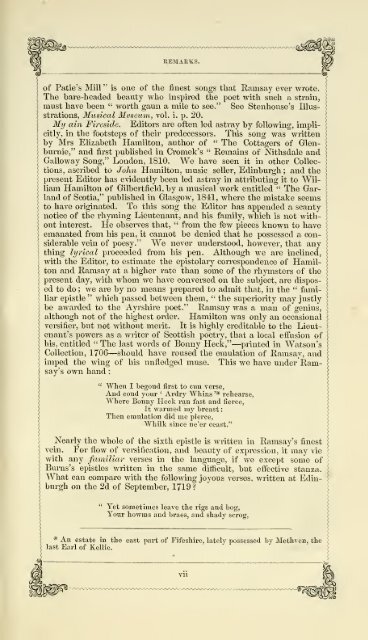[A composite volume : containing The ballads and songs of Ayrshire ...
[A composite volume : containing The ballads and songs of Ayrshire ...
[A composite volume : containing The ballads and songs of Ayrshire ...
Create successful ePaper yourself
Turn your PDF publications into a flip-book with our unique Google optimized e-Paper software.
,<br />
burgh<br />
:<br />
:<br />
REMARKS.<br />
<strong>of</strong> Patie's Mill " is one <strong>of</strong> the finest <strong>songs</strong> that Ramsay ever wrote.<br />
<strong>The</strong> bare-headed beauty who inspired the poet with such a strain,<br />
must have been " worth gaun a mile to see." See Stenhouse's Illusstrations,<br />
Musical Mvseunn, vol. i. p. 20.<br />
;<br />
My ain Fireside. Editors are <strong>of</strong>ten led astray by following, implicitly,<br />
in the footsteps <strong>of</strong> their predecessors. This song was written<br />
by Mrs Ehzabeth Hamilton, author <strong>of</strong> " <strong>The</strong> Cottagers <strong>of</strong> Glenburnie,"<br />
<strong>and</strong> first published in Cromek's " Remains <strong>of</strong> Nithsdale <strong>and</strong><br />
Galloway Song," London, 1810. We have seen it in other Collections,<br />
ascribed to John Hamilton, music seller, Edinburgh ; <strong>and</strong> the<br />
present Editor has evidently been led astray in attributing it to William<br />
Hamilton <strong>of</strong> Gilbertfield, by a musical work entitled " <strong>The</strong> Garl<strong>and</strong><br />
<strong>of</strong> Scotia," published in Glasgow, 1841, where the mistake seems<br />
to have originated. To this song the Editor has appended a scanty<br />
notice <strong>of</strong> the rhyming Lieutenant, <strong>and</strong> his family, which is not without<br />
interest. He observes that, " from the few pieces known to have<br />
emanated from his pen, it cannot be denied that he possessed a considerable<br />
vein <strong>of</strong> poesy." We never understood, however, that any<br />
thing lyrical proceeded from his pen. Although we are inclined,<br />
with the Editor, to estimate the epistolaiy correspondence <strong>of</strong> Hamilton<br />
<strong>and</strong> Ramsay at a higher I'ate than some <strong>of</strong> the rhymsters <strong>of</strong> the<br />
present day, with whom we have conversed on the subject, are disposed<br />
to do ; we are by no means prepared to admit that, in the " familiar<br />
epistle " which passed between them, " the superiority may justly<br />
be awarded to the <strong>Ayrshire</strong> poet." Ramsay was a man <strong>of</strong> genius,<br />
although not <strong>of</strong> the highest order. Hamilton was only an occasional<br />
versifier, but not without merit. It is highly creditable to the Lieutenant's<br />
powers as a writer <strong>of</strong> Scottish poetry, that a local efiVision <strong>of</strong><br />
his, entitled " <strong>The</strong> last words <strong>of</strong> Bonny Heck," — printed in Watson's<br />
Collection, 1706—^should have roused the emulation <strong>of</strong> Ramsay, <strong>and</strong><br />
imped the wing <strong>of</strong> his unfledged muse. This we have under Ramsay's<br />
own h<strong>and</strong><br />
" When I begoud first to ciin verse,<br />
And coud your Ardry Whins '* rehearse.<br />
'<br />
Where Bonny Pleck ran fast <strong>and</strong> fierce,<br />
It warmed my breast<br />
<strong>The</strong>n emulation did me pierce,<br />
Whilk since ne'er ceast."<br />
Nearly the whole <strong>of</strong> the sixth epistle is written in Ramsay's finest<br />
vein. For flow <strong>of</strong> versification, <strong>and</strong> beauty <strong>of</strong> expression, it may vie<br />
with any familiar verses in the language, if we except some <strong>of</strong><br />
Burns's epistles written in the same difficult, but efiective stanza.<br />
^Vhat can compare with the following joyous verses, written at Edinon<br />
the 2d <strong>of</strong> September, 1719 <br />
" Yet sometimes leave the rigs <strong>and</strong> bog.<br />
Your ho-wms <strong>and</strong> braes, <strong>and</strong> shady scrog,<br />
* An estate in the east part <strong>of</strong> Fifeshire, lately possessed by Methven, the<br />
last Earl <strong>of</strong> Kellie.<br />
vn

















